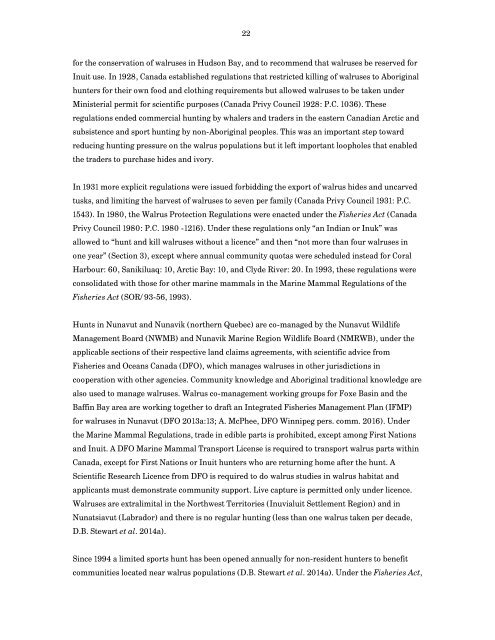The State of Circumpolar Walrus Populations
walrusreport
walrusreport
You also want an ePaper? Increase the reach of your titles
YUMPU automatically turns print PDFs into web optimized ePapers that Google loves.
22<br />
for the conservation <strong>of</strong> walruses in Hudson Bay, and to recommend that walruses be reserved for<br />
Inuit use. In 1928, Canada established regulations that restricted killing <strong>of</strong> walruses to Aboriginal<br />
hunters for their own food and clothing requirements but allowed walruses to be taken under<br />
Ministerial permit for scientific purposes (Canada Privy Council 1928: P.C. 1036). <strong>The</strong>se<br />
regulations ended commercial hunting by whalers and traders in the eastern Canadian Arctic and<br />
subsistence and sport hunting by non-Aboriginal peoples. This was an important step toward<br />
reducing hunting pressure on the walrus populations but it left important loopholes that enabled<br />
the traders to purchase hides and ivory.<br />
In 1931 more explicit regulations were issued forbidding the export <strong>of</strong> walrus hides and uncarved<br />
tusks, and limiting the harvest <strong>of</strong> walruses to seven per family (Canada Privy Council 1931: P.C.<br />
1543). In 1980, the <strong>Walrus</strong> Protection Regulations were enacted under the Fisheries Act (Canada<br />
Privy Council 1980: P.C. 1980 -1216). Under these regulations only “an Indian or Inuk” was<br />
allowed to “hunt and kill walruses without a licence” and then “not more than four walruses in<br />
one year” (Section 3), except where annual community quotas were scheduled instead for Coral<br />
Harbour: 60, Sanikiluaq: 10, Arctic Bay: 10, and Clyde River: 20. In 1993, these regulations were<br />
consolidated with those for other marine mammals in the Marine Mammal Regulations <strong>of</strong> the<br />
Fisheries Act (SOR/93-56, 1993).<br />
Hunts in Nunavut and Nunavik (northern Quebec) are co-managed by the Nunavut Wildlife<br />
Management Board (NWMB) and Nunavik Marine Region Wildlife Board (NMRWB), under the<br />
applicable sections <strong>of</strong> their respective land claims agreements, with scientific advice from<br />
Fisheries and Oceans Canada (DFO), which manages walruses in other jurisdictions in<br />
cooperation with other agencies. Community knowledge and Aboriginal traditional knowledge are<br />
also used to manage walruses. <strong>Walrus</strong> co-management working groups for Foxe Basin and the<br />
Baffin Bay area are working together to draft an Integrated Fisheries Management Plan (IFMP)<br />
for walruses in Nunavut (DFO 2013a:13; A. McPhee, DFO Winnipeg pers. comm. 2016). Under<br />
the Marine Mammal Regulations, trade in edible parts is prohibited, except among First Nations<br />
and Inuit. A DFO Marine Mammal Transport License is required to transport walrus parts within<br />
Canada, except for First Nations or Inuit hunters who are returning home after the hunt. A<br />
Scientific Research Licence from DFO is required to do walrus studies in walrus habitat and<br />
applicants must demonstrate community support. Live capture is permitted only under licence.<br />
<strong>Walrus</strong>es are extralimital in the Northwest Territories (Inuvialuit Settlement Region) and in<br />
Nunatsiavut (Labrador) and there is no regular hunting (less than one walrus taken per decade,<br />
D.B. Stewart et al. 2014a).<br />
Since 1994 a limited sports hunt has been opened annually for non-resident hunters to benefit<br />
communities located near walrus populations (D.B. Stewart et al. 2014a). Under the Fisheries Act,


